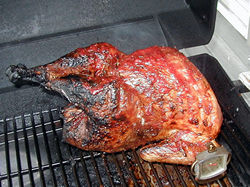Grilling 101 - The GrillJunkie Basics and Top 10 Rules:For more tips, recipes, and products....Visit us online at
http://www.grilljunkie.comGrilling like any other kind of cooking is a combination of technique and art. Grilling refers to foods that are cooked more quickly and directly over high heat. The fuel and heat source are not separated from the cooking chamber thus providing for an environment that provides for high heat. Grilling temperatures typically reach 500°F or more, but any temperature above 300°F is considered a grilling temperature. The high heat of grilling sears the surface of meat, creating a flavorful browned crust.
The difference between grilling and cooking on the stove or in the oven is that grilling is, in essence, is a combination of both. A grill provides direct heat from the gas burners or the charcoal and indirect heat that fills the grill when the lid is down. An average gas or charcoal grill can reach 500 degrees in a matter of minutes. Unlike with an oven, where you can simply place the food inside, set the temperature and timer, and walk away for a while, while grilling you must remain ever engaged, proactive, and vigilant.
The high heat, both direct and indirect is the foundation of grilling.
You will want to leverage this heat to cook food, quickly. And due to this fact, foods cook fast on a grill you have to turn them in order to cook them evenly, without burning. However, this is where practice, experience, and the art of grilling come in, because if you turn things too often you will slow the process of cooking and this can lead to food that is tough and dry. The secret is turning only when necessary. When cooking a steak or a hamburger, and checking it for desired doneness, be sure to get down low, by the edge of the grill, be ever-careful not to burn yourself. Gently lift up the corner of the meat. When the lines from the cooking grate start to turn black it's time to turn the food.
Knowing when to turn and when things are cooked involved practice, experience, and is in essence, the whole art of grilling. The rest of it, like indoor cooking and baking, is recipes, marinades, and trick. Everything else is recipes, marinades, and tricks. The art of grilling is also the hardest thing to teach, and must be accompanied by practice and experience. You will not be able to learn the art of grilling simply be reading, you must take what you read and practice, make mistakes, experiment, and experience! As an example, ideally, a steak will be turned only once, however, if the steak is very thick (more than about 1 1/2 inches) you might need to do it three times to get it cooked through to the center.
Like with all things that take time to learn and require practice and patience, you must, start simple when learning the art of grilling. Keep those first few steaks a little on the thin side, and once well practiced move up to a filet mignon. This will help you get the hang of grilling and allow you to properly cook food with more enjoyment, and without a lot of trouble. As you evolve as a GrillJunkie, and become more experienced with the art of grilling, you can work up to more challenging techniques and dishes.
Here are a few rules of good grilling. Rule 1: Always keep your grill clean. This is an essential for good tasting food and safety!
Rule 2: Always keep a close eye on what you’re grilling. Be proactive, watchful, and in control.
Rule 3: Always keep your grill in a safe location away from anything flammable like lighter fluid, fences, your house, etc.
Rule 4: When grilling low fat meats and other foods that stick, use oil or cooking spray on the grill grate However, never apply cooking spray to a lit grill.
Rule 5: Do not use spray bottles of water to control flare-ups. Flare-ups are caused by too much fat and too much heat. Trim excess fat and when you turn meat on the grill move it to a different part of the grill.
Rule 6: Do not add oil-based sauces, or marinades to meat on the grill. This inevitably causes burning.
Rule 7: Always allow yourself plenty of time to prepare and cook. Don't leave your family and/or guests waiting.
Rule 8: Spice up your food a good hour or two before you hi the grill. This time allows the flavor sink in.
Rule 9: Use the proper grilling tools. Using anything else, such as a table fork, which is good for eating, are not so good or safe for grilling.
Rule 10: Always be sure to plan for and make more than enough food for everyone including unexpected guests. The last thing you will need is an angry mob on your hands.
Visit our site for more tips, recipes, and help celebrate America's love of grilling with our unique line of aprons, t-shirts, beer steins, etc.!!
http://www.grilljunkie.com









